There is a stretch of the train journey from London to Falmouth that runs alongside, almost in, the sea. To the left of the mainline tracks is an expanse of open water and, if you look down, children watching their sandcastles wash away. To the right, between sheer cliffs and hillocks, the countryside of Cornwall opens up. It’s a remarkable experience, as if the speed of the train forces it to skate across the surface of the water before emerging in this very different part of England. This remote location, shaped through hundreds of years of tin mining and other exploitation, is considering a bid for Manifesta in 2014. In response to this issue the Falmouth Convention was a three-day international meeting of artists, curators and writers, convened by Teresa Gleadowe to discuss the relevance of time and place to contemporary art practice.
Focusing on the beautiful harbour town of Falmouth, over the course of the four days much of Cornwall’s rich history was explored. Arriving in the town I gathered my bearings in a site so different from the Hackney I had just abandoned, before making it over to University College Falmouth for Lucy Lippard’s keynote speech. Titled ‘Imagine Being Here Now: Towards a Multicentred Exhibition Process’, the deliberateness of placing this conference out of London and in the location of its subject was clear. Lippard had lived in the South West of England before, but despite this she didn’t pretend to understand the complexities in making and showing art specific to this place. Rather, she focused on a location she was an expert in, New Mexico and Santa Fe. The talk was fast paced and wide ranging, often contradictory and confrontational.
Lippard proposed an antagonistic approach to cultural tourism. She felt the visited were often neglected in preference for the visitor and that a critical regionalism rather than rural gentrification could help redress the balance. By paying great attention to the writer J. B. Jackson, Lippard raised some surprising parallels between the American and English southwest. Jackson believed that the beauty of landscapes was not just an aspect, but their very essence and that this beauty derived from the human presence. For me, Lippard’s talk and the thinking of Jackson would colour discussion for the rest of the conference.
The first evening finished in the Falmouth Townhouse, a pleasant pub overlooking the harbour. The release for the convention had promised an emphasis on ‘the exchange of views and experience’ and pleasingly a great deal of time was set aside for informal discussion. Participants ranged from art students in the Falmouth area to internationally successful artists and curators. At times it was only in retrospect that I realised who I had been talking with. One of the questions arising from the conference was how best to structure openness. I would suggest the organisation of this convention is a very good start. The following day would provide further room for relaxed conversation.
The participants were divided into six groups on the second day for a series of field trips exploring the Cornish landscape. Assembly, an artist residency space in St. Just, led a coastal walk and discussion of their isolated locality. Returning to their days as Falmouth art students, Lucy Gunning and Tacita Dean split their group into land-based and waterborne parties. One walked on a biographical ramble along the coastline of the town while the other communicated with mirrors from a boat off the shore. Members of this trip returned glowing from the beating sun that graced us that day. The third trip was led by Falmouth-based arts organisation Urbanomic. They led an exploration of the Gwennap mining district, looking at the ‘mighty, infernal machine that traumatised the Cornish landscape and kick started the industrial revolution’. Simon Fujiwara recalled experiences of his teenage years spent in St Ives whilst his group toured the historic St Ives artists’ colony. Jeremy Millar focused on the twelfth century story of Tristan and Iseult with passages of the tragic story of adulterous love recited by poet Jane Tozer in the environment of its setting. Artists included in each group reported their experiences back to the rest of the convention on the final day.
Each of the field trips explored various themes of the convention. Of the human and the rural, the internationalism of the periphery and, as well as exploring Cornwall’s unique artistic legacy, the significance of time and place in relation to contemporary art more generally. My field trip was entitled ‘Teleport’ and took me on a coach tour led by Steven Rowell and Daro Montag of Cornwall’s distinctive history as a hub of international communications. Our first destination, the Marconi Museum in Poldhu, was the site of the first transatlantic broadcast. A large monument in its grounds, apparently of a lichen-covered cat’s head, turned out to be a representation of the two telecommunication towers stood on the globe.
For lunch I was delighted to visit the most southerly English restaurant at Lizard Point, a historic centre of communications. I advised international participants on what would best accompany their Cornish pasty. Inevitably there were many people and places that we held in common and conversation flowed smoothly, continuing between the hedgerows and down gullies in the cliff face. As we rambled and bussed our way around the coastline our next destination was the Lloyds Signal Station before visiting the Goonhilly Satellite Earth Station, which transmitted the first satellite TV signals via Telstar 1. By 5pm we had only reached the halfway point of our schedule as we went on to visit the Newlyn Art Gallery, ate cream tea at The Exchange, Penzance and visited the private view of Lily van der Stokker’s exhibition at Tate St Ives. The day was rounded off by a late night discussion back in Falmouth between Hans Ulrich Obrist and Kader Attia. Concluding at half past midnight, we prepared ourselves for tomorrow.
On the third day, an orange glow radiated from an audience decidedly more rubescent than previously. Saturday was dedicated to an extensive conference exploring the many issues on which the convention was focused. Tom van Gestel and Tacita Dean gave their views of non-urban site-specific commissions from the perspective of the commissioner and the commissioned. Simon Fujiwara described his experience of a residency in Los Angeles, and a slide show from Paulina Olowska described the context in which she is now working in rural Poland. Kitty Scott of the Banff Centre, Andrzej Przywara of the Foksal Gallery Foundation, Donna Lynas of Wysing Arts Centre and Adam Sutherland of Grizedale Arts discussed their varying approaches to residencies and then Bassam El Baroni presented his work on Manifesta 8. Jeremy Millar gave a poetic summary of the day’s issues before the programme was completed with closing remarks by Andrew Nairne and Sir Nicholas Serota. As we had become accustomed, events continued into the night with an opening at Urbanomic Studio and an evening screening by Annexinema before drinks at the Falmouth Townhouse.
The last time I had travelled to Cornwall I remember getting lost from my parents and spending a terrifying fifteen minutes running around Land’s End. Fortunately, this time I felt much more at home. My conclusions from the convention were many and varied. The limitations of the exhibition format were repeatedly addressed as alternative forms of engagement with artists were proposed. We discussed interdisciplinary formats, working as, or with artists in ways that cannot be defined easily as exhibitions or as residencies. Also stressed was the necessity for an unfolding and ongoing relationship to location rather than a four-week show, or fifteen-minute panic at Land’s End. I understood that though Cornwall may be an extremity of the English mainland it is also able to act as an international centre. By their distance from traditional art centres, rural and peripheral sites can attract international connections, whilst maintaining a relationship to the local community. Lucy Lippard had earlier defined a local as someone who gives as much as they take from a specific location. On my train ride back to London I was well aware of how much I had taken from my stay in Cornwall.
Gareth Bell-Jones
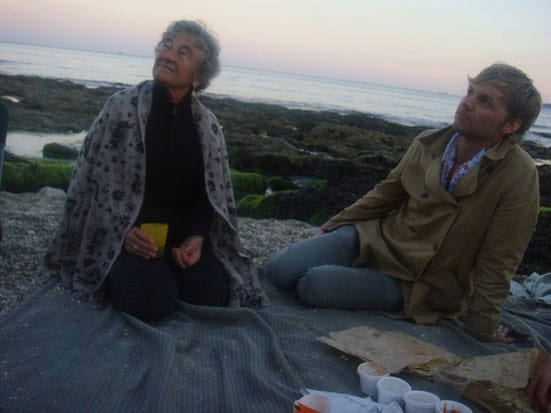
Lucy Lippard and Geoffrey Farmer on the beach at Falmouth
Photo courtesy of Tacita Dean
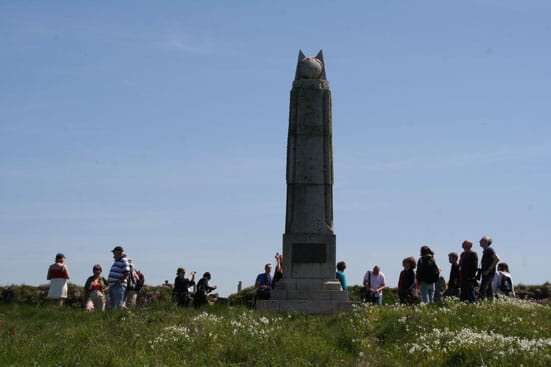
The Marconi monument at Poldhu, visited on the field trip led by Steven Rowell, Teleport - A Tour of the Lizard's Landscape of Telecommunication
Photo courtesy Sara Bowler
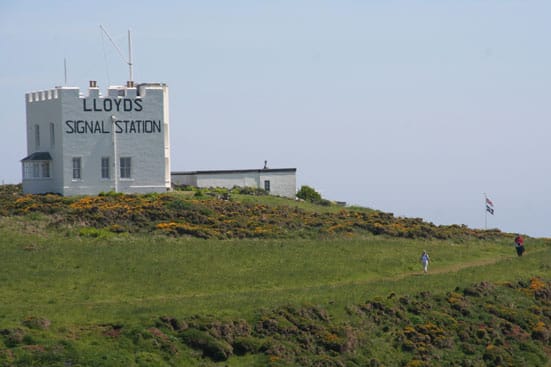
The Lloyds Signal Station near Lizard Point on the Teleport field trip
Photo courtesy Sara Bowler
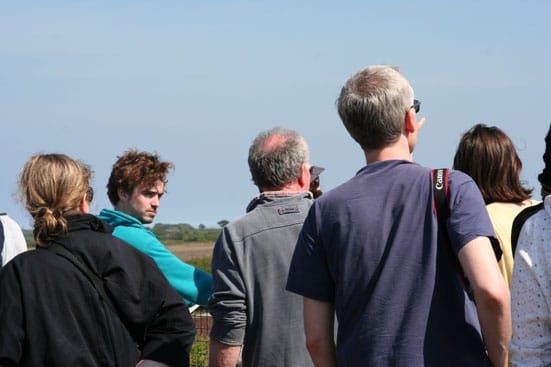
Members of the Teleport field trip
Photo courtesy Sara Bowler
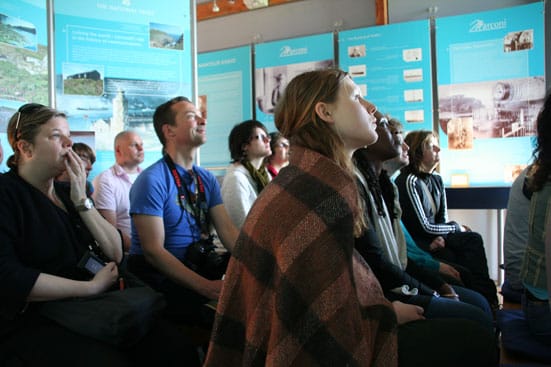
Members of the Teleport field trip
Photo courtesy Sara Bowler